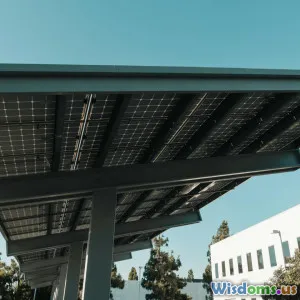
What Will Nanotechnology Mean for Clean Energy Breakthroughs?
7 min read Discover how nanotechnology is revolutionizing clean energy with innovations in solar, storage, and efficiency breakthroughs. (0 Reviews)
What Will Nanotechnology Mean for Clean Energy Breakthroughs?
The unstoppable quest for clean, sustainable energy sources has never been more urgent. Amid escalating climate change concerns, dwindling fossil fuels, and burgeoning global energy demands, the spotlight has turned to breakthroughs that could radically transform the clean energy landscape. One of the most promising frontiers in this endeavor? Nanotechnology.
Nanotechnology, the science of manipulating materials at the atomic and molecular scales, unlocks properties and capabilities unattainable at larger scales. As Nobel laureate Richard Feynman once mused, "There’s plenty of room at the bottom." Today's scientists and engineers are harnessing that room to reshape how we generate, store, and use energy — promising a low-carbon future powered by innovation.
Harnessing Solar Power: Nano-Enabled Efficiency and Beyond
Solar energy remains a cornerstone of clean energy. Yet, traditional solar panels grapple with efficiency limits and high manufacturing costs.
Enhancing Photovoltaic Cells with Nanomaterials
Nanostructured materials like quantum dots and perovskite nanosheets are revolutionizing photovoltaic technology. Quantum dots, semiconductor nanoparticles just a few nanometers in size, can be tuned to absorb different light wavelengths. This tunability enables solar cells to harvest a broader spectrum of sunlight, boosting efficiency.
Perovskite solar cells, recently heralded for skyrocketing in efficiency from 3% in 2009 to over 25% in 2023, leverage nanoscale control over crystal growth to maximize light capture while reducing defects. According to a 2023 study published in Nature Energy, incorporating nanopatterned interfaces reduced recombination losses, further improving cell performance.
Furthermore, nanostructured surfaces can reduce reflection—meaning more light is absorbed rather than lost, enhancing output without adding extra cost.
Flexibility and Lightweight Panels
Nanotechnology also enables flexible and lightweight solar panels through the use of thin films composed of nanomaterials. This flexibility opens up new installation possibilities—on curved surfaces, textiles, or wearables—expanding where and how solar power can be deployed.
Revolutionizing Energy Storage
Clean energy breakthroughs are incomplete without efficient energy storage. Solar and wind power’s intermittent nature demands robust batteries and supercapacitors.
Nanomaterials in Battery Electrodes
Traditional batteries suffer from limited capacity and slow charge rates. Introducing nanostructured electrodes—such as silicon nanowires for lithium-ion batteries—dramatically increases surface area, enabling faster ion transport and higher energy density.
A leading example comes from Stanford researchers (2021), who developed a nanostructured electrode with silicon anodes that improved battery lifespan by 2.5 times while cutting charge times in half.
Supercapacitors with Nano-Tuned Porosity
Beyond batteries, supercapacitors charged by nanoscale engineering show promise for rapid charge-discharge cycles with long lifespans. Controlling pore size in carbon-based nanomaterials optimizes ion movement and storage, pushing supercapacitor capabilities closer to rivaling batteries.
Such innovations could profoundly affect electric vehicles, making charging quicker and driving ranges longer.
Catalysts and Energy Conversion
Efficient catalysts are critical to clean energy processes like water splitting for hydrogen fuel production and carbon dioxide reduction.
Nanoscale Catalysts for Green Hydrogen
Hydrogen, touted as the 'fuel of the future', traditionally demands expensive and rare platinum catalysts to split water into hydrogen and oxygen. Nanotechnology helps design catalysts with atomically dispersed catalytic sites, dramatically reducing the amount of precious metals needed.
A promising breakthrough from MIT (2022) demonstrated a cobalt-nanoparticle catalyst embedded in a nitrogen-rich carbon matrix, producing green hydrogen with comparable efficiency but a fraction of the cost.
CO2 Conversion and Beyond
Another exciting avenue involves nanocatalysts that convert CO2 directly into useful fuels or chemicals, providing a twofold win by reducing greenhouse gases and generating energy-rich products. Nanostructured copper catalysts, for example, show enhanced selectivity toward ethylene and ethanol.
Challenges and the Path Ahead
While nanotechnology heralds transformative potential, challenges remain. Scaling lab successes to commercial production demands addressing material stability, cost-effectiveness, and environmental safety.
Additionally, the environmental impact of nanomaterials themselves — toxicity and lifecycle effects — requires stringent scrutiny.
Yet, the pace of research and investment is accelerating. Public and private sector initiatives worldwide are funneling billions into nanotechnology for energy applications, signaling a broad commitment.
As Dr. Angela Belcher, nanobiotechnology pioneer, states, "We are at the dawn of a nanotech-powered revolution in energy, where nature's own strategies inspire solutions fitting the complexity of global needs."
Conclusion
Nanotechnology stands poised as a linchpin in the pursuit of clean energy breakthroughs. From quantum dot solar cells harvesting sunlight more completely, to rapid-charging nanobatteries, and innovative catalysts unlocking green hydrogen production, these tiny innovations carry enormous promise. As research progresses and challenges are met, nanotechnology could help pivot humanity toward a sustainable, carbon-neutral energy future—transforming the world’s energy foundations atom by atom.
By embracing and supporting nanotech-based clean energy advances, individuals, industries, and governments alike have a profound opportunity to partake in reshaping planet Earth’s energy destiny. The immense potential nested within the nanoscale could well be the key to powering the world in cleaner, smarter, and more efficient ways than ever before.
Rate the Post
User Reviews
Popular Posts




















